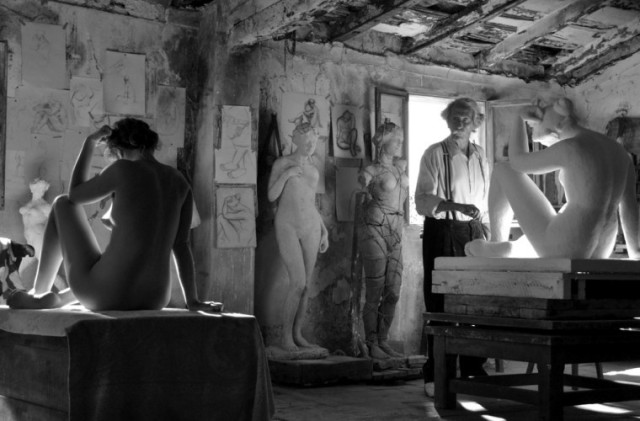 AIDA FOCH AND JEAN ROCHFORT IN THE ARTIST AND THE MODEL
AIDA FOCH AND JEAN ROCHFORT IN THE ARTIST AND THE MODEL b]
Which is the model?In black and white, with a faultless evocation of the Forties, Spanish director Fernando Truba's
The Artist and the Model depicts an aging sculptor called Marc Cros (he has known Cézanne and Matisse) who briefly works with a young woman, a refuge from Spain, just taken over by Franco, Mercè (Aida Folch). It's the summer of 1943, in occupied France, not far from the Spanish border. Jean Rochefort is the sculptor, and as his once beautiful wife Léa we get none other than Claudia Cardinale. The screenplay was written by Jean-Claude Carriére, who wrote all of Luís Buñuel's French language scripts. These credentials are enough to recommend this quiet, inconsequential but immaculately composed film to festival and mature art house audiences.
American viewers may remember Jean Rochefort playing opposite Johnny Hallyday in Patrice Leconte's 2002
L'homme du train/Man on the Train. He even had a role in the high-speed French thriller
Tell No One. But I always think of the story told in the documentary
Lost in La Mancha (also 2002) of how Terry Gilliam's film version of
Don Quixote was sabotaged when Jean Rochefort hurt his back and could not play the lead. Tall, aristocratic, fine-boned, but with an erratic slightly sleepy look in his eyes, the perennial Rochefort, who is now 82 and has been in movies since the Fifties, would have been a perfect Don Quixote -- for looks, anyway. He seems a bit distant as a actor, and usually appears on the periphery of films even when he's at the center of them. That's why it's moving to see him as the main character in a classic, almost mythical story. Girl comes, artist makes sculpture of girl, girl goes away, artist fades. A famous artist in retreat, Marc Cros is a tired and disillusioned man, not a stretch for Rochefort with his weary, far-away look.
What distinguishes this film apart from its Mediterranean light and quiet rhythms (World War II is winding down, but seems far away), is its sweetness. The young woman is not pouty like the one who poses in the pretty new film
Renoir (R-V 2013). She seems ready to make love to the old artist, and does kiss and caress and hug him. And he tells her his wife was the most beautiful model who ever posed for him. Mercè and Léa caress each others faces in parting and tell each other how beautiful they are. The sculptor struggles to get started (what else?) but then turns out a mid-sized plaster cast of a woman with elbow on knee that's almost worthy of Maillol. In a major monologue, he tells Mercè there are two and only two proofs of the existence of God: the body of woman, and olive oil -- a life lesson from the 81-year-old Jean-Clause Carrière, no doubt. One of the true stars of the film is the artist's cluttered studio full of maquettes, plaster sculptures, drawings, and soft light. Props to cameraman Daniel Vilar for his fine use of black and white, which heightens the focus on the charcoal drawings and plaster models of the briefly reborn old sculptor. Aida Folch hasn't much to do but pose nude, but she has an earthiness that rings true in this otherwise awfully slow-moving and self-conscious effort.
Compare this little film with JacquesRivette's almost four-hour
La belle noiseuse (1991) starring Michel Piccoli, and you will see how much more complex a treatment of the artist-model relationship can be. And compare the careers of Piccoli and Rochefort. Piccoli is 87 now, but he is still starring in major films. Rocefort seems, in contrast, almost like a model himself more than an artist. With his tall, thin stature, his handsome "triste figura" and fine mane of hair, he always looks good in every shot, but does not add much more to the shot than his looks. However, the sadness in his face plays well into the final moments of this little film.
El artista y la modelo (the original title Spanish even though 95% of the dialogue is in French: Cardinale speaks French fluently, having been born in 1938 in Tunis) debuted at San Sebastien in September 2012 and was released in France 13 March 2013. It was not too badly received (Allociné press rating 3.4), but critics did note the sad truth that it is stiff, boring, clichéd, and yes, a "pale copy of
La belle noiseuse." Screened for this review as part of the SFIFF, April 3013.





